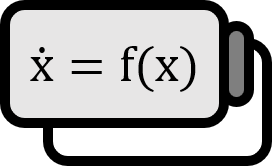Hopf Bifurcation
Definition
Hopf bifurcation is a bifurcation in which the stability of a fixed point changes as a parameter varies, leading to the appearance or disappearance of a new periodic orbit in a dynamical system.
Normal Form 1
Let’s consider the complex number $z$ represented as $z = x + iy$ or in polar coordinates as $z = r e^{i \phi}$. The Hopf bifurcation can be categorized into two types: supercritical and subcritical, each with the following normal forms:
- Supercritical:
In Cartesian coordinates $$ \begin{align*} \dot{x} =& \alpha x - y - x \left( x^{2} + y^{2} \right) \\ \dot{y} =& x + \alpha y - y \left( x^{2} + y^{2} \right) \end{align*} $$ In the complex plane $$ \dot{z} = \left( \alpha + i \right) z - z \left| z \right|^{2} $$ In polar coordinates $$ \begin{align*} \dot{r} =& r \left( \alpha - r^{2} \right) \\ \dot{\theta} =& 1 \end{align*} $$ - Subcritical:
In Cartesian coordinates $$ \begin{align*} \dot{x} =& \alpha x - y + x \left( x^{2} + y^{2} \right) \\ \dot{y} =& x + \alpha y + y \left( x^{2} + y^{2} \right) \end{align*} $$ In the complex plane $$ \dot{z} = \left( \alpha + i \right) z + z \left| z \right|^{2} $$ In polar coordinates $$ \begin{align*} \dot{r} =& r \left( \alpha + r^{2} \right) \\ \dot{\theta} =& 1 \end{align*} $$
Diagram
Supercritical: As $\alpha$ increases, in $\alpha \le 0$, $z = 0$ transitions from a stable node to an unstable node at $\alpha > 0$, leading to the emergence of a stable limit cycle.


Subcritical: As $\alpha$ decreases, in $\alpha \ge 0$, $z = 0$ transitions from an unstable node to a stable node at $\alpha < 0$, leading to the emergence of an unstable limit cycle.


Explanation
Hopf bifurcation, also known as Poincaré–Andronov–Hopf bifurcation for its full name, is a type of bifurcation easily observed in mathematical models related to Lotka-Volterra predator-prey models or chemical reactions2 3.


See Also
- Neimark-Sacker bifurcation: a discrete-time equivalent of Hopf bifurcation.
